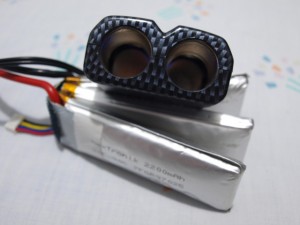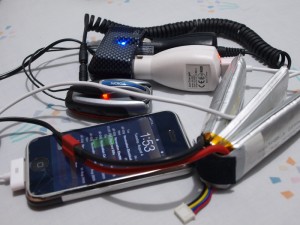Earlier this evening, the air-con guy called me up and asked to meet up at my new house to discuss how we would love run the array of ugly thick gas pipes around the house. Since the electrical wirings are out, there’s no light in the house and we needed one.
I keep an old Li-Po (Lithium Polymer) battery from my RC heli in the back of my car so I could use it with a 12V flourescent tube whenever the occassion requires. I’ve been using it for quite some time already and never had to recharge the 12V pack for almost a year.
I brought the battery and flourescent light along to meet the air-con guy. We kept talking until the lights went out and drained the battery well beyond its safe minimum capacity and it puffed like a pillow.
Bloated Lithium batteries indicate the loss of electrolyte and loss of cell capacity. The electrolyte converts to gasses that are flamable and potentially toxic, that’s why Lithium batteries do not have mechanisms to allow these gasses to escape – known as venting.
Lithium batteries bloat for many reasons, but most of them are caused by abuse. Examples of usage abuse are over-charging and over-discharging. However, it can also be caused by poor manufacturing or defects.
If you ever recall your old mobile phones with batteries that bloat, this is exactly what happened. Original cells from phone manufacturers have safety cut-off circuits that prevent over-charging or discharging of the batteries, but some third party batteries omit them to cut cost. The use of third party “desktop chargers” also either omit these circuits entirely or contain circuits made of cheap components, making voltage detection inaccurate.
Lithium is an unstable metal but makes batteries with high energy density, making 8 to 10 hour battery life on modern laptops possible. However, they come at a cost – charging and discharging them must be controlled or they may explode and cause serious injury. This is the reason why Lithium batteries are so damn expensive!
And for that very reason, Lithium batteries cannot be disposed off normally. If you observe carefully, commercial Lithium batteries found in devices suchs as laptops have a logo with a garbage bin and a cross over it telling you not to dispose it in a bin.
How then, should one dispose a Lithium battery?
For commercial electronics, you can send the battery back to your manufacturer for proper disposal.
Alternatively, completely discharge a Lithium battery before disposing them so that they do not explode, produce harmful gasses and kill your garbage collector.
There are several sites on the Internet recommending to discharge the battery by hooking it up to a lamp or electronic device of sorts, which I thought was just a waste of energy. Afterall, the battery still contains useful charge.
So I hooked up a car Cigarette Lighter Adaptor (CLA) I made out of a CLA extension I bought off Carrefour…
And then hooked that up to charge my iPhone and bluetooth headset!
Not shown in the picture above is the Lithium battery being placed on an old hard drive. I did that to prevent an igniting battery from burning my cotton bed sheet or wooden floor. It is a good idea to place the battery on a non flammable surface if you are charging Li-Po batteries for RC.
I will also use this technique to discharge some of my good Li-Po batteries that have been kept away in the storage for a while. It’s good to store Lithium batteries at 40% charge, or approximately 3.7V per cell (varies slightly with different Lithium battery chemistries – there are several in the market now.) At this voltage, Lithium batteries lose minimum capacity over prolonged periods of storage.
Once the battery is discharged, the right thing to do next is to put it in a bucket of salt water and puncture the pack. Allow it to completely discharge to zero volts before disposing. That, of course, will be done tomorrow when my iPhone and bluetooth is fully charged!
Update: I brought the battery outdoors and punctured a small hole in the outer skin (not through the battery!) to allow the gasses to escape, then I sealed the pin sized hole with a piece of tape. Now the batteries have deflated and I will check if they are still capable of holding charge and not bloat dangerously. If its OK, I keep is as a power source for my flourescent lamp. I don’t recommend doing so if you aren’t experienced with handling Li-Po batteries, though.



